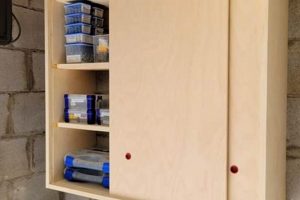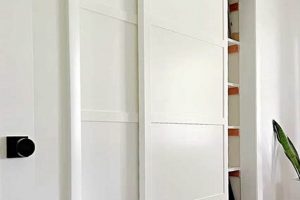Custom fabricated interior coverings for vehicle doors offer a method of personalizing and enhancing a vehicle’s aesthetic. These bespoke elements, often constructed from materials such as fabric, vinyl, or composite boards, replace the original factory-installed components. For example, an individual might create tailored coverings to match a specific color scheme or incorporate unique design features.
The creation of bespoke interior car door enhancements allows vehicle owners to express individuality and improve the overall interior environment. Historically, custom vehicle interiors have been a domain of professional auto shops, however, the accessibility of materials and online tutorials has made this process achievable for a wider range of enthusiasts. The benefits include cost savings compared to professional services and the satisfaction of completing a hands-on project.
The subsequent sections will detail material selection, necessary tools, construction methods, and installation procedures for crafting these individualized vehicle interior components. Guidance on design considerations and safety precautions will also be provided, ensuring a comprehensive understanding of the fabrication process.
Essential Considerations for Custom Vehicle Interior Panels
Creating custom vehicle interior panels requires careful planning and execution. The following guidelines offer critical insights into ensuring a successful project, emphasizing durability, aesthetics, and safety.
Tip 1: Material Selection is Paramount: Choose materials that can withstand temperature fluctuations and UV exposure. Marine-grade vinyl or durable fabrics laminated to a rigid substrate offer longevity. Avoid materials prone to cracking or fading.
Tip 2: Accurate Measurements are Crucial: Meticulously measure the existing door panel to create a template. Account for any contours or recesses. A precise template minimizes waste and ensures a snug fit.
Tip 3: Utilize Professional-Grade Adhesives: Select adhesives specifically designed for automotive interiors. These adhesives resist heat and moisture, preventing delamination. Improper adhesion can compromise the panel’s integrity.
Tip 4: Prioritize Secure Attachment: Replicate the factory mounting points as closely as possible. Use appropriate clips or fasteners designed for automotive applications. Loose or improperly secured panels pose a safety hazard.
Tip 5: Sound Dampening Considerations: Integrate sound-deadening materials between the panel and the door frame to reduce road noise and improve audio quality. This addition enhances the vehicle’s comfort and acoustic properties.
Tip 6: Edge Finishing for Durability: Properly finish all edges of the panel to prevent fraying or delamination. Edge binding or a folded-over material edge provides a clean and durable finish, increasing the lifespan of the panel.
The successful creation of custom vehicle interior panels hinges on attention to detail, material selection, and adherence to safety standards. Proper execution results in an aesthetically pleasing and functional upgrade that enhances the vehicle’s value and comfort.
The subsequent article sections will elaborate on specific construction techniques and provide troubleshooting guidance for common challenges encountered during the fabrication process.
1. Material Durability
Material durability constitutes a foundational aspect of successful custom vehicle interior component fabrication. The longevity and visual appeal of these components are directly influenced by the inherent properties of the selected materials. Considerations extend beyond initial aesthetics, encompassing resistance to environmental factors and physical wear.
- UV Resistance
Prolonged exposure to ultraviolet radiation can degrade many materials, leading to fading, cracking, and embrittlement. Selecting materials with inherent UV resistance, such as marine-grade vinyls or fabrics treated with UV inhibitors, is critical. Failure to account for UV exposure results in premature deterioration and necessitates frequent replacement.
- Temperature Stability
Vehicle interiors experience substantial temperature fluctuations. Materials must withstand these extremes without warping, cracking, or delaminating. High-density polyethylene (HDPE) and certain composite materials exhibit excellent temperature stability, making them suitable substrates. Inadequate temperature stability can lead to structural failure and aesthetic degradation.
- Abrasion Resistance
Door panels are subject to repeated contact from occupants, seatbelts, and other objects. Materials with high abrasion resistance, such as heavy-duty fabrics or coated vinyls, are essential for maintaining a presentable appearance. Insufficient abrasion resistance results in scuffing, tears, and visible wear over time.
- Moisture Resistance
Exposure to moisture, whether from humidity or spills, can damage susceptible materials. Fabrics should be treated with water-repellent finishes, and substrates should be resistant to water absorption. Moisture-induced degradation can lead to mold growth, delamination, and structural weakening.
These facets of material durability collectively determine the lifespan and overall quality of custom vehicle interior panels. Selecting appropriate materials based on these considerations ensures a durable, aesthetically pleasing, and long-lasting upgrade to the vehicle’s interior.
2. Accurate Template
The creation of bespoke interior door components for vehicles hinges critically on the precision of the template employed. An accurate template dictates the dimensional conformity and aesthetic integration of the finished element within the vehicle’s interior. Deviations from dimensional accuracy compromise the overall fit and finish, detracting from the intended enhancement.
- Dimensional Fidelity
Dimensional fidelity refers to the degree to which the template accurately replicates the contours and dimensions of the existing door panel. Precise measurements and careful transfer of these measurements to the template material are paramount. Errors in dimensional fidelity result in gaps, overlaps, or misalignment during installation, necessitating rework or rendering the component unusable.
- Mounting Point Replication
An accurate template must precisely locate and replicate the mounting points used to secure the original door panel. These mounting points may include clips, screws, or other fastening mechanisms. Failure to accurately replicate these mounting points compromises the structural integrity of the installed element and can lead to rattling, detachment, or damage to the vehicle’s door frame.
- Feature Integration
Modern door panels often incorporate features such as speaker grilles, door handles, or window controls. An accurate template must account for these features, ensuring that they are properly integrated into the design of the custom panel. Failure to accurately integrate these features can impair their functionality or compromise the aesthetic appeal of the finished product.
- Material Allowance
The template must account for the thickness of the materials used to construct the custom door panel. Failure to factor in material thickness can result in a panel that is too small or too large, preventing proper fitment. Additionally, allowance should be made for seam allowances and edge finishing techniques, ensuring a clean and professional appearance.
The aforementioned elements underscore the inextricable link between template accuracy and the successful fabrication of custom vehicle interior components. Diligence in template creation directly translates to a superior final product, characterized by precise fitment, functional integration, and enhanced aesthetic appeal. Conversely, a flawed template undermines the entire process, resulting in a substandard outcome and wasted resources.
3. Secure Attachment
The stability and safety of custom vehicle interior elements are contingent upon the robustness of their attachment mechanisms. When constructing bespoke door panels, reliable fixation is paramount, influencing both the longevity of the installation and the safety of vehicle occupants. Inadequate attachment can lead to panel detachment during vehicle operation, posing a distraction to the driver and potentially obstructing access to essential controls. For example, a loosely affixed panel might shift during a turn, impeding access to the window control or door handle, thereby increasing the risk of an accident.
Effective securement methodologies encompass a range of techniques, including the utilization of manufacturer-specified clips, purpose-designed automotive fasteners, and high-strength adhesives. The choice of attachment method should be predicated on the substrate material, the weight of the panel, and the stresses it will encounter during regular use. An illustrative scenario involves replacing a factory door panel with a heavier, custom-built unit incorporating additional sound-deadening materials. In such instances, the original clips may prove insufficient, necessitating the use of reinforced fasteners or a combination of mechanical and adhesive bonding. Furthermore, proper alignment of the panel during installation is crucial, ensuring that all attachment points engage correctly and distribute the load evenly.
Ultimately, prioritizing secure attachment in the fabrication of custom vehicle interior panels is not merely an aesthetic consideration, but a fundamental safety imperative. The selection and implementation of appropriate attachment methods directly correlate with the structural integrity of the panel and the safety of the vehicle occupants. Neglecting this aspect introduces avoidable risks and undermines the overall quality of the modification. Continued diligence in ensuring robust attachment systems is therefore essential for responsible and effective vehicular customization.
4. Adhesive Strength
Adhesive strength plays a crucial role in the successful construction of custom interior door components for vehicles. The longevity and structural integrity of panels fabricated using this approach are directly proportional to the adhesive’s ability to maintain a secure bond between disparate materials. Compromised adhesive strength leads to delamination, material separation, and eventual failure of the door panel. For example, when applying a fabric covering to a composite board substrate, insufficient adhesive strength will result in bubbling, wrinkling, or complete detachment of the fabric, rendering the panel aesthetically displeasing and functionally compromised.
The selection of an appropriate adhesive must consider factors such as material compatibility, temperature resistance, and shear strength. Automotive interiors are subject to wide temperature variations, and the chosen adhesive must maintain its bonding properties across this range. Contact adhesives, epoxy resins, and specialized automotive trim adhesives are commonly employed, each offering varying degrees of strength and suitability for specific material combinations. Proper surface preparation, including cleaning and degreasing, is also essential for maximizing adhesive performance. Failure to adequately prepare surfaces inhibits bonding and reduces overall adhesive strength. Furthermore, applying uniform pressure during the curing process ensures intimate contact between the materials, optimizing bond formation.
Ultimately, understanding and applying principles of adhesive science are indispensable for achieving durable and reliable custom vehicle interior elements. The appropriate selection, application, and curing of adhesives mitigate the risk of premature failure, ensuring the longevity and aesthetic quality of the finished panel. Neglecting this fundamental aspect undermines the entire fabrication process, resulting in substandard components and diminished vehicle value.
5. Edge Finishing
Edge finishing, a critical aspect of custom vehicle interior component fabrication, directly influences the durability, aesthetics, and safety of the finished product. Proper edge treatment prevents material degradation, enhances visual appeal, and minimizes the risk of injury from sharp or unfinished edges. The integration of appropriate finishing techniques is, therefore, indispensable for successful outcomes.
- Material Stabilization
Raw edges of materials used in fabricating interior door elements, such as fabric, vinyl, or composite boards, are susceptible to fraying, cracking, or delamination. Edge finishing techniques, including binding, hemming, or coating, encapsulate and protect these edges, preventing material degradation and extending the lifespan of the door panel. For example, applying a vinyl edge trim to a composite board prevents moisture absorption and delamination, ensuring long-term structural integrity.
- Aesthetic Enhancement
Edge finishing contributes significantly to the overall visual appeal of the component. Clean, uniform edges create a professional, finished look, enhancing the perceived quality of the custom work. Techniques such as color-matched binding or decorative stitching can complement the overall interior design. Conversely, unfinished or poorly finished edges detract from the aesthetic, creating a perception of amateur craftsmanship.
- Safety Considerations
Unfinished edges of certain materials can be sharp or abrasive, posing a risk of injury to vehicle occupants. Edge finishing techniques eliminate these hazards by creating smooth, rounded surfaces. Rolled edges, edge banding, or the application of flexible edge trim provide a protective barrier, minimizing the risk of cuts or abrasions during entry, exit, or normal vehicle operation.
- Integration with Attachment Mechanisms
The method of edge finishing can influence the selection and effectiveness of attachment mechanisms. For example, a thicker edge finish may require longer fasteners or necessitate adjustments to mounting clip placement. Conversely, a flush edge finish may allow for the use of adhesive bonding or concealed fasteners. Consideration of the interplay between edge finishing and attachment ensures a secure and aesthetically pleasing installation.
These facets of edge finishing demonstrate its integral role in the successful creation of custom interior door components. Proper attention to edge treatment not only enhances the visual appeal and durability of the finished product but also contributes to the safety and overall quality of the vehicle’s interior. The selection and implementation of appropriate edge finishing techniques should, therefore, be a primary consideration in any fabrication project.
6. Sound Dampening
The incorporation of sound-dampening materials within custom-fabricated vehicle door panels directly affects the acoustic characteristics of the vehicle’s interior. The primary cause is the reduction of structure-borne vibrations, wherein road noise, engine noise, and external sound waves transmit through the vehicle’s metal body panels. Applying sound-dampening materials to interior door surfaces mitigates these vibrations by increasing mass and reducing panel resonance. This is a critical component of fabrication because it directly affects the occupants experience of acoustic comfort, noise reduction, and clarity of the vehicles audio system. For instance, a vehicle traveling on a rough road surface typically generates considerable noise within the cabin; however, implementing a layer of butyl rubber-based sound deadener on the interior door skin reduces the amplitude of these vibrations, resulting in a demonstrably quieter ride.
Practical application involves selecting appropriate sound-dampening materials based on their density, thickness, and vibration absorption capabilities. Butyl rubber composites are frequently employed for their effectiveness in damping low-frequency vibrations. Closed-cell foam materials are also commonly used to absorb airborne noise and further insulate the interior from external sound sources. These materials are typically applied to the interior surface of the door panel, as well as the inner door skin, maximizing their noise reduction potential. Furthermore, when constructing replacement door panels, integrating sound dampening as a core part of the layering, and securing its position in the panel’s construction, ensures optimal performance, preventing unwanted shifting that could diminish the acoustic benefits.
In summary, the inclusion of sound-dampening materials is an integral element of custom-fabricated vehicle door panels. Challenges may include the added weight of the materials and the potential for increased panel thickness, which may require adjustments to attachment methods. However, the benefits of enhanced acoustic comfort and reduced noise outweigh these challenges for many vehicle owners. Understanding and implementing effective sound-dampening techniques contribute significantly to the overall quality and value of customized vehicle interiors.
Frequently Asked Questions Regarding DIY Door Panels
The following questions address common concerns and misconceptions associated with the construction and installation of custom vehicle door panels. The responses aim to provide clarity and guidance based on accepted best practices.
Question 1: What is the expected lifespan of a custom fabricated vehicle door panel?
The lifespan of a custom-fabricated vehicle door panel is contingent upon material selection, construction techniques, and environmental exposure. Panels constructed from durable, UV-resistant materials and assembled with professional-grade adhesives can reasonably be expected to last five to ten years under normal conditions. However, neglect, extreme temperature fluctuations, or improper cleaning can significantly reduce this lifespan.
Question 2: Is specialized equipment required to undertake this type of project?
While sophisticated machinery is not strictly necessary, certain tools are highly recommended for achieving professional results. A sewing machine capable of handling heavy-duty fabrics, a jigsaw for cutting composite boards, and a pneumatic staple gun for securing upholstery are valuable assets. Furthermore, precision measuring tools, such as calipers and rulers, are essential for creating accurate templates.
Question 3: Are there specific safety precautions to observe during the construction process?
Eye protection is paramount when cutting or sanding materials. A respirator should be worn when working with adhesives or paints to prevent inhalation of harmful fumes. Additionally, caution should be exercised when using power tools, adhering to all manufacturer-specified safety guidelines. It is also advised to disconnect the vehicle’s battery before working on any electrical components within the door panel.
Question 4: How does one ensure proper alignment and fitment of a custom panel?
Accurate template creation is the cornerstone of proper alignment. Meticulous measurement and careful transfer of dimensions to the template material are essential. It is also advisable to perform a test fit of the panel before final assembly to identify and correct any discrepancies. Replicating the factory mounting points as closely as possible ensures secure and precise attachment.
Question 5: What types of materials are best suited for sound deadening purposes?
Butyl rubber-based sound deadeners are highly effective at damping low-frequency vibrations, while closed-cell foam materials excel at absorbing airborne noise. Combining these materials provides optimal sound insulation. The mass and density of the chosen material directly correlate with its sound-deadening capabilities.
Question 6: How does one prevent moisture damage to custom door panels?
Selecting moisture-resistant materials is the primary defense against water damage. Marine-grade vinyls and fabrics treated with water-repellent finishes are recommended. Sealing exposed edges with edge banding or sealant further protects the substrate from moisture penetration. Additionally, ensuring proper drainage within the door cavity prevents water accumulation.
The considerations outlined above represent critical factors in the successful fabrication and installation of custom vehicle door panels. Careful attention to these details promotes longevity, safety, and aesthetic satisfaction.
The next article section will focus on troubleshooting common problems encountered during the fabrication process and provide practical solutions.
DIY Door Panels
This exploration of custom vehicle door panel construction has emphasized the critical elements governing successful outcomes. Material selection, template accuracy, secure attachment methods, adhesive strength, edge finishing, and sound dampening techniques have been detailed, reflecting core considerations in the pursuit of personalized vehicle interiors. The effective implementation of these principles directly influences the longevity, safety, and aesthetic quality of the resulting components.
The information presented serves as a foundation for informed decision-making in the realm of custom vehicle interior fabrication. Diligence in planning and execution remains paramount. The ability to create bespoke components not only enhances the vehicle’s aesthetic appeal, but enables vehicle owners to personalize their experience, further contributing to the enduring legacy of vehicular customization.







